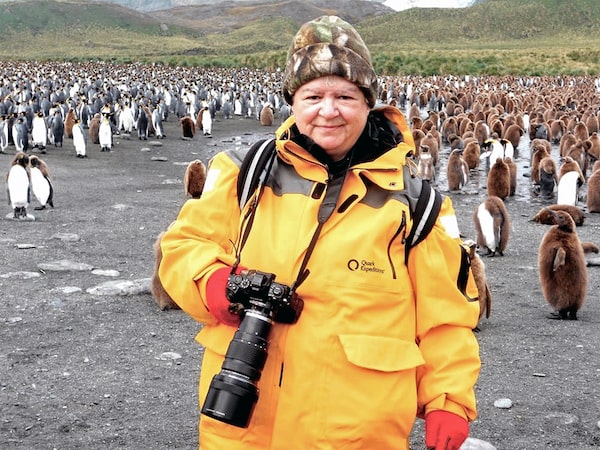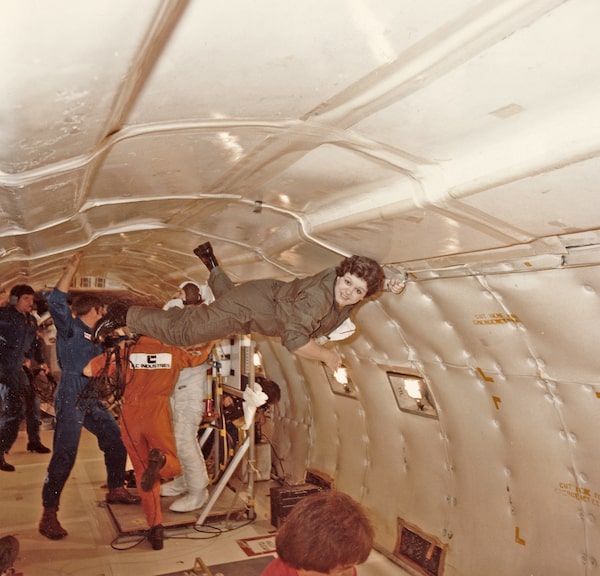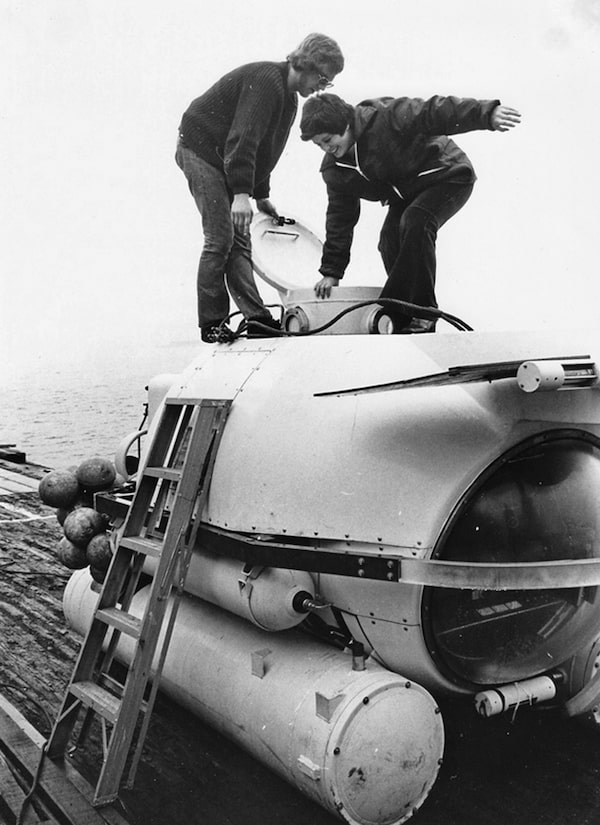
Science journalist Lydia Dotto on assignment in the Antarctic on Dec. 15, 2015 to Jan. 1, 2016.Courtesy of the Family
Throughout her career as a writer, Lydia Dotto was determined to get the entire country talking about science. At times that work, first for The Globe and Mail and later as a freelancer and author, led the adventurous reporter into extremely challenging environments.
While on assignment for the Globe in 1973, for example, Ms. Dotto completed two dives under the Arctic ice in Resolute Bay on Baffin Island. A decade later, she participated in a zero-gravity training flight with astronauts at the Johnson Space Center in Houston, Texas.
“Her excitement and perspective were contagious in her writing, and helped bring the astronaut and space programs to generations of readers,” retired Canadian astronaut Chris Hadfield said.
Ms. Dotto, who died of endometrial cancer last month at the age of 73, was also a leader among her peers. In 1983, she took the bold step of arranging one of the first teleconferences in Canada, which involved arranging a flatbed truck to deliver a giant satellite dish that was set-up in front of the Royal Ontario Museum (ROM) in Toronto for a day. The teleconference was part of the annual conference of the Canadian Science Writers’ Association’s (CSWA) in Toronto, and the dish was used to link CSWA satellite groups meeting in six other cities across the country.
Dotto scuba diving with Douglas Elsey under the ice in the Arctic in May, 1974. The object of the exercise was to get a feel for the stresses and challenges facing divers and scientists participating in Arctic IV, a two-month expedition to test diving equipment and human performance in northern waters.Handout
“I persuaded some of the telecom companies to provide the infrastructure needed,” Ms. Dotto recalled in a 2020 interview. “It took months to organize the thing but it went off pretty well. I’m amused looking back at that event from the perspective of 2020, when we can just pick up our phones and Zoom or FaceTime anyone whenever we want.”
Lydia Dotto was born with a shock of black curly hair and a red face on May 29, 1949 at 5 p.m. in Cadomin, Alta., to Augustino (Gus) and Assunta (née Paron) Dotto, both children of Italian immigrants. Eighteen months later her only sibling, Terry Dotto, was born – both of them coal miner’s daughters.
The coal mines in Cadomin closed down in 1952, and the Dotto family moved to Edmonton the following year. Gus worked for Molson Brewery there for the next 25 years, and Assunta worked at the Great West Garment Company. (Gus died in 1991, followed by Assunta in 2012.)
As a student, Lydia loved the first day of school and for months after all she did was talk about her studies. She always got Honours throughout elementary school, high school and university.
The Dotto family liked to tell the tale of Lydia’s brush with Beatlemania as a teenager. The local radio station in Edmonton ran a contest where the top prize was a trip to see the Beatles in their first ever Canadian concert on Aug. 22, 1964, at Empire Stadium in Vancouver. After Lydia’s sister walked more than two miles to pick up entry ballots from the nearby radio station, Lydia stole some of them and entered the contest. She won what was a teenage girl’s dream at the time. She flew to Vancouver to see the band perform while Terry had to stay home. Lydia became a lifelong Beatles fan.
Lydia graduated from Austin O’Brien High School, in Edmonton, in 1968 and enrolled in the honours journalism degree program at Carleton University, in Ottawa, later that year. As part of her studies she interned at the Edmonton Journal as a reporter during the summer of 1969, and later at the Toronto Star.
When she graduated with honours from Carleton in 1971 she received the Class Medal. The following year, The Globe and Mail hired 23-year-old Ms. Dotto to be the paper’s science writer, replacing David Spurgeon, who had filled the role since 1960.
On her first day, Ms. Dotto met Joan Hollobon, then The Globe’s medical reporter, and for the next several years the two women were the lead writers on the science and medical beats at Canada’s national newspaper. Their combined voices and interests cemented what became a lifelong friendship.
Stephen Strauss, who worked as a reporter for The Globe and Mail from 1979 until 2004, noted that the journalism profession was much less welcoming to women in those days. “I think Lydia Dotto [and Joan Hollobon] showed that a woman could be the best in science reporting in an era when ‘girls’ [supposedly] didn’t do science.”

Dotto participates in zero-gravity training in 1983 at Johnson Space Center, Houston, Texas.Courtesy of the Family
At The Globe, Ms. Dotto soon began covering space missions, including Skylab, Apollo, the Space Shuttle and the International Space Station programs. She developed a special rapport with Canada’s astronauts, in particular with Marc Garneau, Canada’s first astronaut in space, and the first Canadian to return to space; as well as with Mr. Hadfield, who in 2001 made the first space walk by a Canadian; and with the Canadian Space Agency, which was established in 1989.
“I sat with Lydia for a whole day once in NASA’s Mission Control in Houston, on console with me as CAPCOM [capsule communicator], talking with the crew,” Mr. Hadfield recalls. “She saw it as a writer might: an exciting whodunit, with a team of investigators trying to solve what happened and what to do about it.”
In June, 1973 she was the first female member of the press corps aboard the USS Ticonderoga aircraft carrier covering the splashdown recovery mission for the Skylab 2 space capsule carrying the returning Skylab astronauts. She described this assignment to her sister as “her greatest and most special adventure.”
“It was always the No. 1 memory that she spoke of,” Terry said. “It was the highlight of her life.”
In the late 1980s and 1990s, Ms. Dotto was co-director of SpaceNet, a website affiliated with Marc Garneau Collegiate Institute/the Canadian Space Resource Centre in Toronto, where she also taught science writing.
Encouraged to join by Ms. Hollobon, Ms. Dotto became a member of the Canadian Science Writers’ Association in 1972 shortly after starting at The Globe. She was elected president of the Canadian Science Writers’ Association in 1979 at the age of 29 for a one-year term, the youngest person to serve as president of the organization (now Science Writers and Communicators of Canada).
Ms. Dotto won numerous Canadian Science Writers’ Association Science & Society Journalism Awards and accolades for articles she wrote on topics including nuclear terrorism, high-energy physics, women in science, electromagnetography, global warming, genetic testing and detecting lies.
Ms. Dotto quit her job at The Globe and Mail in 1978, determined to established herself as a leading Canadian freelance science, nature and environmental writer and editor. She served as executive editor of the Canadian Science News Service for a decade beginning in 1982, and encouraged other women to pursue careers in science writing.
“I consider Lydia one of my mentors,” said Pippa Wysong, a science and medical writer who had a regular column for kids called Ask Pippa in The Toronto Star, and now on Twitter. “Shortly after university, I worked part-time for her transcribing interviews for her Canada in Space book. I thought what she did for a living was really cool and said I wanted to become a science writer too. So, she invited me to submit an article for Canadian Science News. I found a story idea, wrote it and she ran it. I wrote for them regularly for a while.”

Dotto boarding Aquarius submarine Egress in Vancouver, on Sept. 19, 1973.Courtesy of the Family
Ms. Dotto was also a mentor to Véronique Morin, who went on to become president of the CSWA and the World Federation of Science Journalists (WFSJ). “She inspired me so much when I was a starting science reporter,” Ms. Morin said, noting the importance of Ms. Dotto’s books on Canadian astronauts and the Canadian space program. “Lydia’s work, in many respects, was a spark for many of us in science reporting in Canada.”
Ms. Dotto was the first woman awarded the Sandford Fleming Medal in 1983 by the Royal Canadian Institute for the Advancement of Science for outstanding achievement in promoting understanding of science among the Canadian public. She was the second person to receive the medal after David Suzuki in 1982.
In the 2000s until her retirement in 2014, Lydia led science writing and communication workshops for scientists in universities, industry and government, and she taught a course in environmental communications at Trent University from 2004 to 2014.
Author of a dozen books, including The Astronauts: Canada’s Voyageurs in Space (1993), Ms. Dotto was also an avid birder and a passionate freelance photographer. Upon retirement, she was determined to travel the world and photograph wildlife – first on a three-week Antarctic expedition in 2015 and most recently touring Australia and New Zealand with her friend Eleanor Sawyer in 2019 – where she captured photos that have been published in various magazines, websites and blogs.
“Lydia introduced me to birding,” Christine Wilson said, “and we travelled to the best birding spots in Ontario. … [She was] always in pursuit of the exotic, the rara avis, which she literally travelled to the ends of the earth to find. And swearing at the gods when denied her exotic goals!”
Ms. Dotto was diagnosed with endometrial cancer in 2018. Following treatment she recovered briefly, but the disease returned with a vengeance in 2020, and the next two years of treatments and clinical trials proved unsuccessful. She moved to Hospice Peterborough on Sept. 12. Four days later, her sister said, “They took Lydia for what is probably her final bath (as it takes too much out of her), gave her her margarita and played Beatles songs. It has given her a great day and a lot of joy.”
Ms. Dotto died peacefully the next day, Sept. 17, in Peterborough, Ont. She leaves her sister, Terry, and many friends.